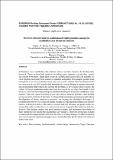Overview of feed resources condition and feeding practices among the smallholder dairy farmers in Tanzania

View/
Date
2016Author
Maleko, David
Msalya, George
Mwilawa, Aloyce
Pasape, Linus
Mtei, Kelvin
Metadata
Show full item recordAbstract
In Tanzania, most smallholder dairy farmers rely on on-farm resources for feeding their
livestock. These on-farm feed resources include grasses, legumes, crop residues, cereals
and oilseed byproducts. These feed resources, in particular pasture and crop residues, do
often fluctuate seasonally both in terms of quantity and quality. For example, pasture tends
to be plenty in wet seasons but becomes very scarce in dry seasons. This fluctuation results
in a reduction of over 40% in milk yield during the dry season. Despite a number of research
and development interventions for curbing the problems of dry season fodder scarcity, the
culture of forage production and preservation in terms of hay or silage, leaf-meal or feed
blocks as a dry season feeding strategy is still limited among the Tanzanian smallholder dairy
farmers. This study aimed at getting an overview of feed resources and dairy cattle feeding
resources in two districts of Tanzania. It is hoped that information generated would inform
development of future innovative solutions for curbing the identified challenges. A
reconnaissance survey was conducted in eight villages in Tanga region including six in Lushoto
and two in Korogwe district. The survey revealed that feed resources are plenty in the wet
season (December to July) but very scarce in dry season (August to November) in both two
districts. The findings suggest that poor feeding strategies and inadequate knowledge on
dairy nutrition exists among the smallholder dairy farmers. Therefore, promoting on-farm
research and development interventions in the areas of feeding strategies, fodder production
and conservation are of paramount importance if sustainable dairy production is to be achieved
in the study sites.
